Preparations for Herborn:
The first exchange in 2023 was to take place in Germany from 7 to 10 February. The Comenius School in Herborn in Central Hesse was to be the destination. The planning for the exchange began at the end of 2022 and the coordinators of the project discussed the course and content of the work via video conferences. At the Comenius School, the preparations began in the end of the year 2022.
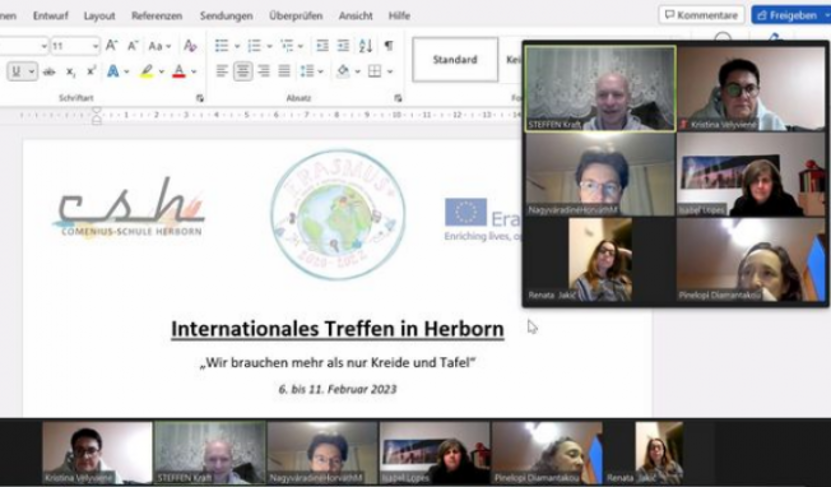
The fifth mobility of the "Let's CAMOLE" project was to be under the motto "We need more than blackboard and chalk". The focus of the exchange was on digitalisation. A special focus was to be placed on how to design the learning environment with digital devices and elements in such a way that it is profitable for all participants. The use of digital devices and the use of different tools and applications in the classroom should be tested and reflected upon. Also the more advanced use of ICT, such as Lego Mindstorms, 3D printing or the creation of radio programs and videos, should be part of the mobility. The new media should also be considered for their benefits in inclusion and the promotion of learning motivation. The use of ICT in school organisation and also the risks of new media should be considered and reflected from a multinational perspective. The aim of the exchange was also to promote cooperation between the young people.
Even before the exchange, the student groups and teachers became familiar with the topics of the mobility. The students prepared presentations about the use of ICT in their countries and collected their wishes for an optimal use of ICT. The teachers developed best-practice examples of using ICT and collected practicable online tools. Also, the students took part in an online survey about their own media use in the context of school.
Before the start of the mobility the flights had to be planned, transfers had to be organised, host families had to be found and a social programme had to be prepared by the teachers of the Comenius-School.
On Monday, 6 February, all participants arrived in Herborn.

The exchange:
From 6 to 10 February, the Let's CAMOLE participants met in Germany. Three teachers and three young people from Hungary, Lithuania, Portugal and Slovenia took part. The exception was the group from Heraklion on Crete - they could only travel to this exchange with two teachers and two pupils.
The days in Herborn had good results. The further work on the project provided many new experiences. The many interesting excursions provided great pleasure and promoted European friendship among the participants. The host school had done a great job of preparation. The great hospitality of the parents should also be mentioned here.
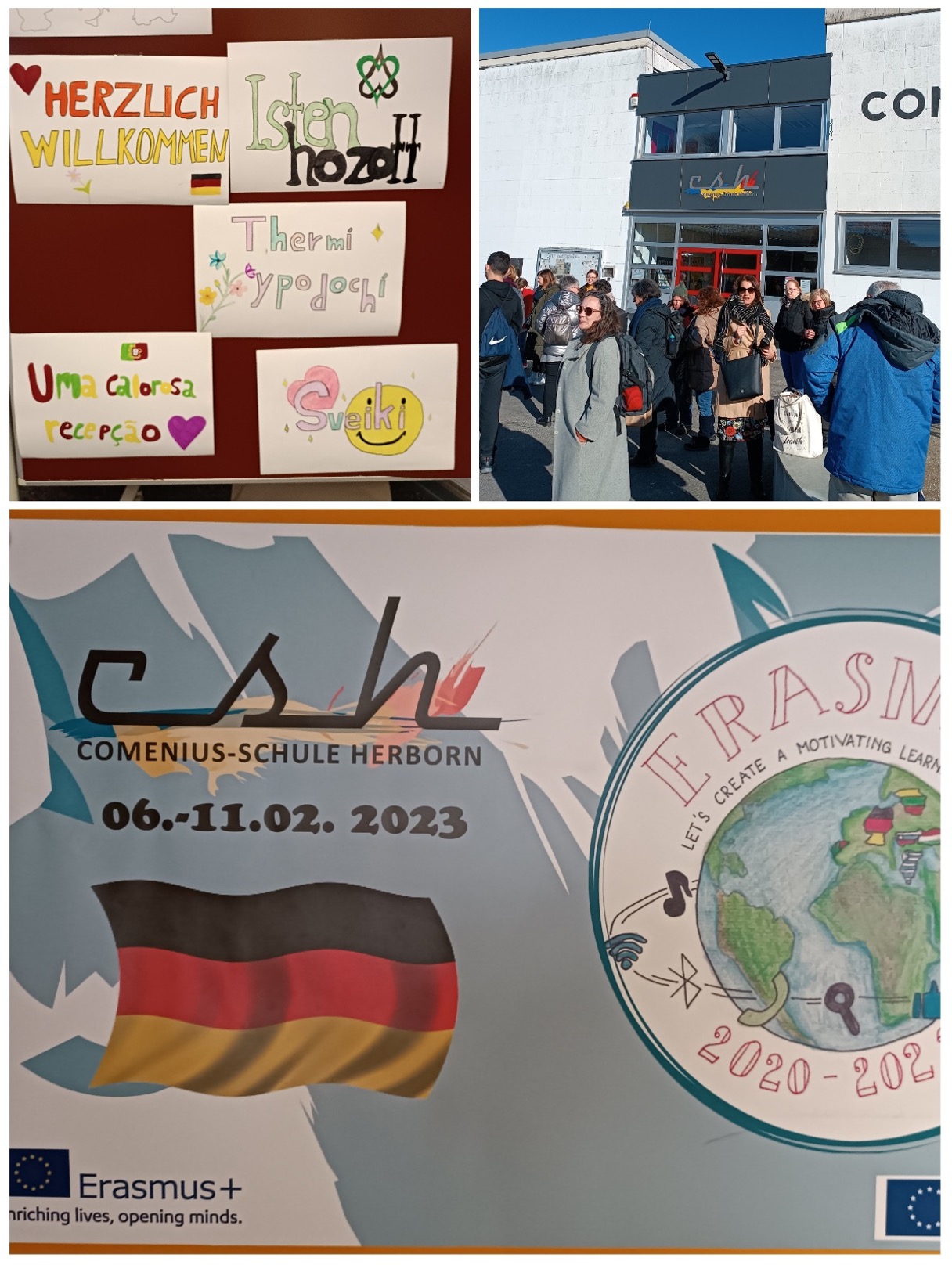
Day 1: Tuesday, 7 February
After the first night in the host families, all participants arrived at the Comenius School full of anticipation. Some participants had already met on Monday on arrival, others were meeting for the first time. The first meeting was a reunion. Many participants already knew each other from previous mobilities. The new participants quickly made friends in the warm atmosphere and were introduced to each other. During the reunion, small gifts and souvenirs were exchanged. The host gifts - Slovenian kernel oil, Hungarian sausage specialities and Portuguese pastries - not only brought joy, but they also brought the participants closer together.

Full of excitement, the groups waited for the official start of the programme in the festively decorated auditorium of the Comenius School.
The welcoming ceremony was very colourful and varied. The school choir offered some songs, a dance group gave a performance and several soloists made musical contributions. The headmaster of Herborn, Micha Gabriel, warmly welcomed the European guests to his school. Project coordinator Steffen Kraft also welcomed the participants and reviewed the great results of the past mobilities. He also presented the programme for the coming days. Some video sequences showed the participants the city of Herborn, the Hessian culture and the Comenius School. The guests could expand their previous knowledge about Herborn in a digital quiz.
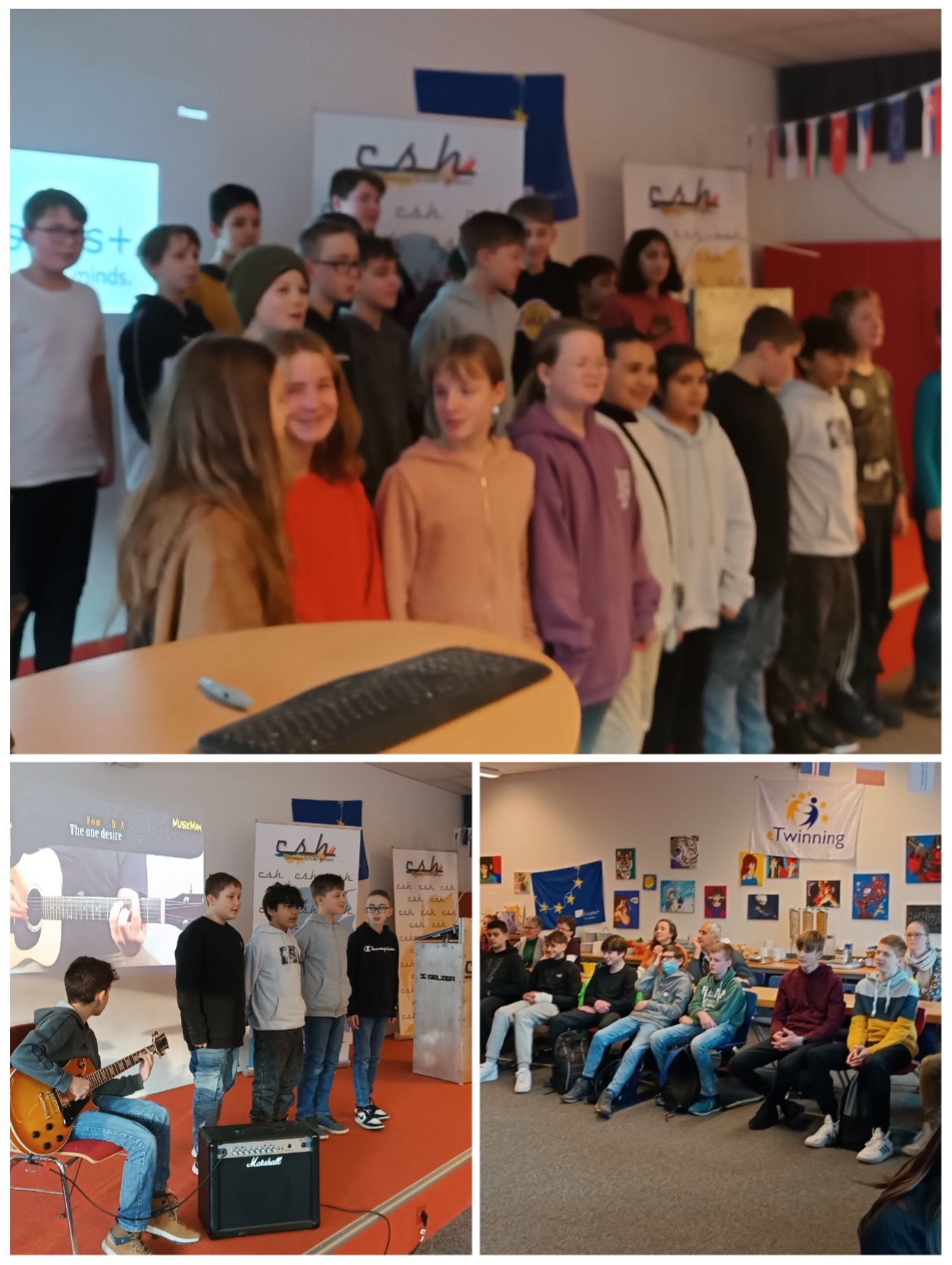
After the welcome programme and a snack, "Icebreakers" were on the agenda. The get-to-know-you games ensured that the project participants could learn a lot about their partners.
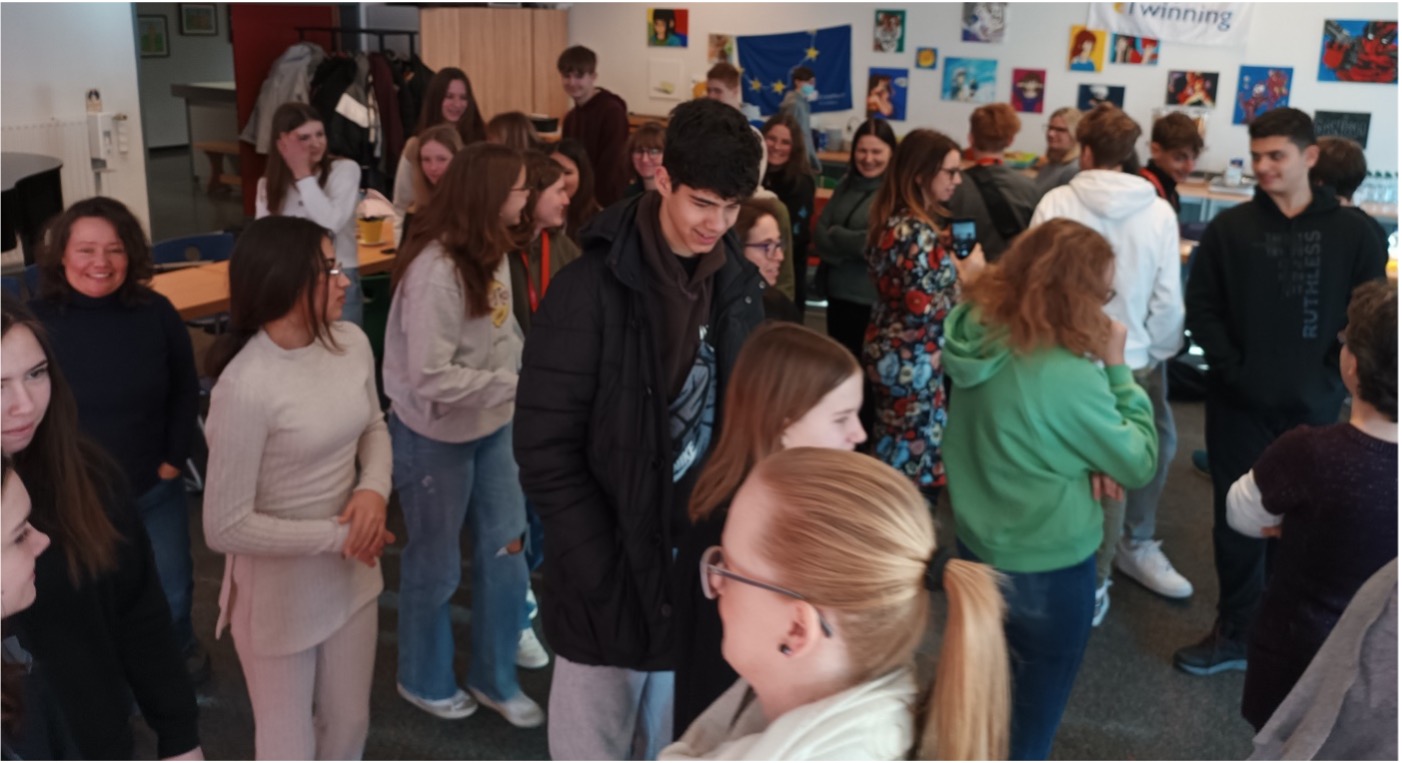
Next on the agenda was a school tour. The pupils got to know the Comenius School better in a digital school rally. In international groups, they had to solve tasks around the school building and the different rooms. The results were collected on a digital pinboard.
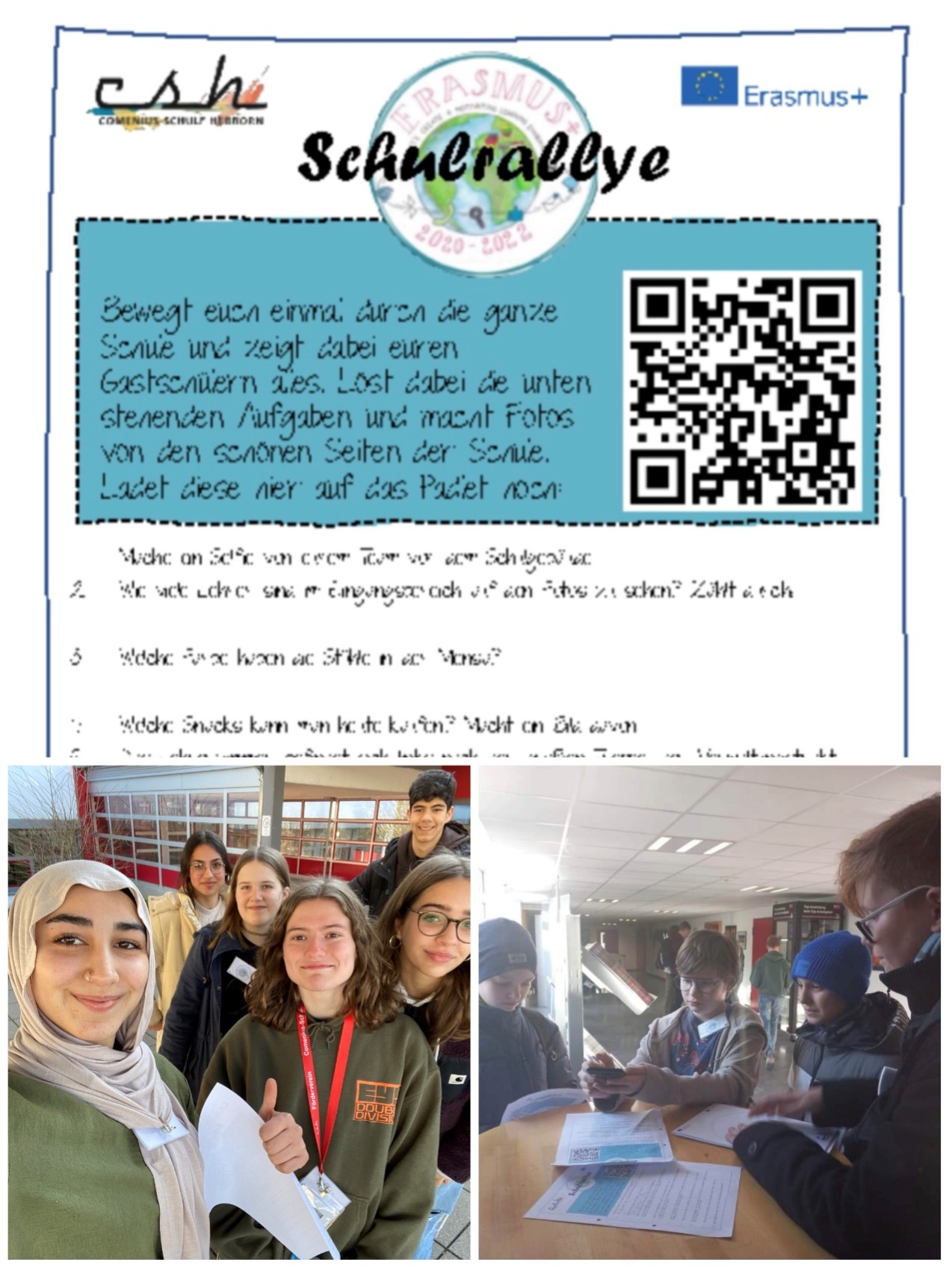
At the same time, the teachers were shown the school building. During the tour, the focus was on the digital elements and the conditions of a supportive learning environment at the Comenius School, in line with the motto of the exchange. The creative furnishing of the primary school inspired the teachers. But also the good technical equipment of the science rooms and the media equipment of the individual classrooms. They were amazed that every classroom has a digital panel and many pupils work with IPads in class. But many guests also mentioned the school's supportive learning environment as positive. For example, the social room, the classroom furniture, the support rooms or the suggestion box and the learning support centre. During the tour, it was also possible to gain insights into the organisation of the school.
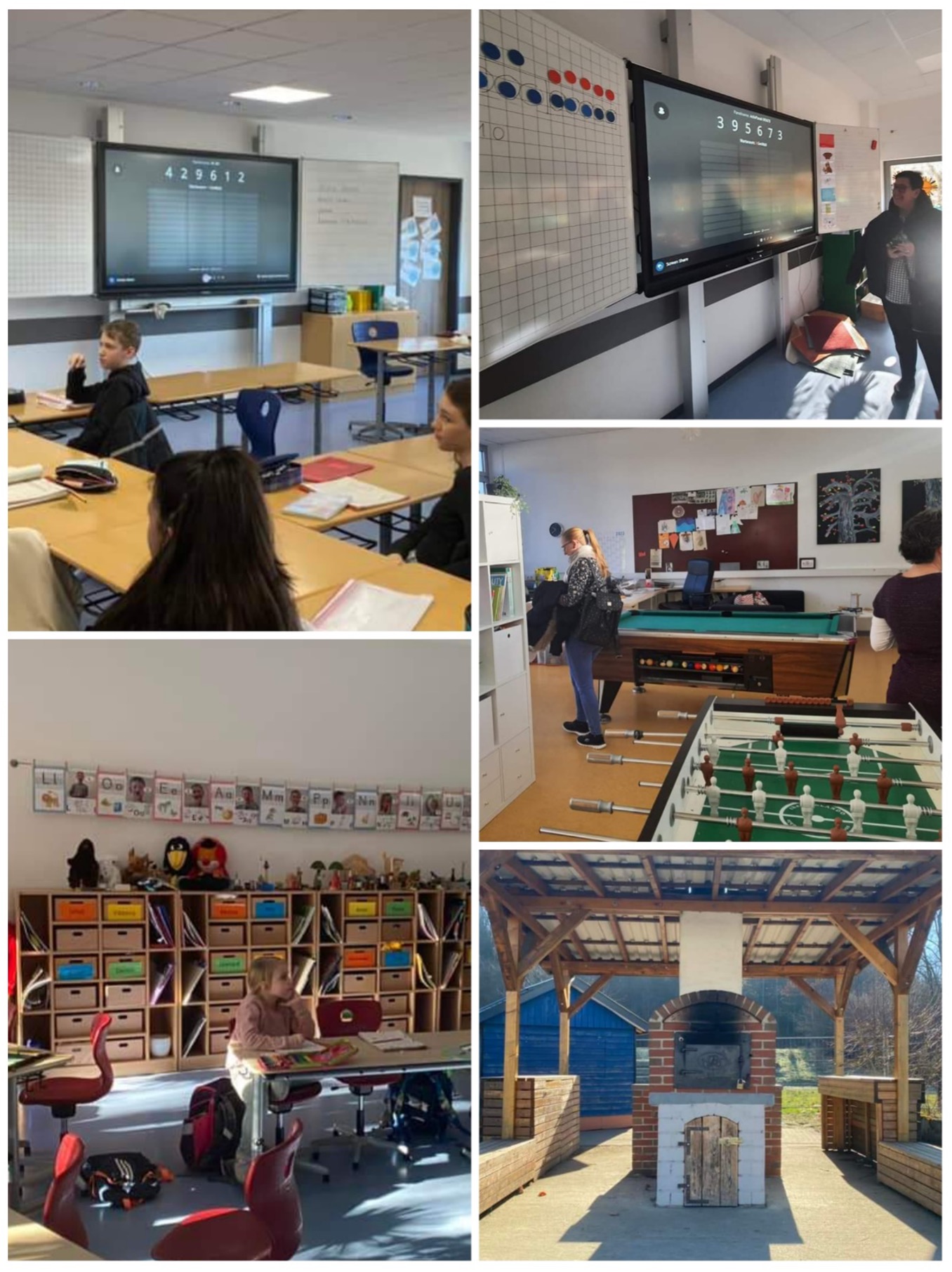
All participants had their first lunch together in the school canteen. Regional cuisine was on the menu and so everyone was able to expand their culinary experiences with Hessian specialities.
After lunch, the school rally was evaluated. Afterwards, the pupils digitally processed what they had seen. Pictures and short video sequences taken during the school rally were collected and combined into a video show. The teacher teams reflected on what they had seen and questions about the school were discussed. In the process, the guests also made comparisons with their own home school systems and initial ideas were generated about which experiences from Herborn could also be implemented at home.

After a break, all participants met in front of the Comenius School. The flags in front of the school were a surprise. The Herborn team had a project flag that showed both the project logo and the individual national flags of the participating countries. Everyone was thrilled to see this flag flying in the wind.
The next part of the programme began in the old town of Herborn. The pupils were divided into teams and familiarised with the app "Actionbound". Actionbound" is a multimedia treasure hunt that is played with smartphones and offers lots of action. Using this app, the pupils had to search for the "treasures" of historic Herborn and get to know the history and culture of their host town. The young people started their treasure hunt in sunny weather and full of motivation. Meanwhile, the teachers were able to learn a lot about Herborn during a guided tour. They learned about the half-timbered houses, explored the medieval university "Hohe Schule", visited Herborn Castle and heard a lot about life in the Middle Ages. Finally, the city guide made the tour with its many anecdotes about Herborn and its inhabitants unforgettable.

After exploring the city, the groups of students and teachers met at the historic town hall. Mayor Katja Gronau had invited the group and warmly welcomed the project participants to Herborn. The first city councillor of Herborn, Michael Müller, also brought warm greetings. As a souvenir, all guests received a small gift.

In the late afternoon, the first day of the exchange ended with a group photo in front of the historic town hall. All participants had an exciting day. Especially for the topic of the project, the day had already shown many suggestions and ideas for the use of digital tools in schools.
Day 2: Wednesday, 8 February
On Wednesday morning, the exchange students accompanied their hosts to regular lessons and were able to experience everyday school life at the Comenius School. They gathered many impressions and, in some cases, experienced new subjects such as science or aesthetics, which they did not know from their schools at home. The guest students also got to know other students in the classes and made new contacts. The breaks, with their many activities, encouraged the students to become active. The delicious snacks in the school canteen also gave them new energy.
The teachers also participated in the lessons by observing the lessons. Afterwards, they reflected. The teachers gave short presentations about their impressions and what they had noticed in a positive and negative way. There was a very interesting exchange about the lessons and the way of teaching and learning at the Comenius School. Some aspects were discussed in more detail. For example, the digital class books, the responsible integration of IPads into lessons and the combined use of digital and analogue elements in lessons. Differentiation in the individual lessons was also discussed by the teachers and seen as a general opportunity in school systems.

Before their trip to Germany, the teachers had "homework" to do. This was now presented. In an online teacher survey, the teachers had provided information on media use at their schools. The evaluation of the survey showed the great interest in digitalisation in Europe. Everyone agreed that digitalisation is also important for preparing pupils for the vocational world and the future. The teachers had also created a digital collection of Web 2.0 tools and described them. Everyone was able to learn about new possibilities for their own digital work in the classroom. In a presentation, the teachers presented concrete "best-practice" examples from their own lessons, which was a benefit and very instructive for all participants.
Lunch was not served in the cafeteria today. But no one had to go hungry. There was a lunch box for each participant. To the surprise of all participants, the lunch box not only contained a snack, but also had the project logo on it.

The participants now travelled by bus to the town of Wetzlar. A visit to the global brand LEICA was on the agenda. In the LEICA museum and during an exciting guided tour through the production area, the groups of pupils and teachers got to know the world brand better. They saw the valuable original LEICA, went on a journey through the history of photography and saw the precision with which the individual parts of a camera are manufactured. The following visit to the "LEICA world of experience" was a real adventure. The pupils went through various stations and were able to try out Leica cameras themselves several times. Especially the use of digital features in photography could be tested - in the line of the project theme.

In the afternoon, the group visited the historic old town of Wetzlar. They were able to visit the cathedral, see Goethe's residence and many souvenir photos were taken on the medieval Lahn bridge. Wetzlar had another task in store for the students. In international groups, they went through the stations of the "optics course". In the course, they were not only able to experience instructive physical phenomena, but also had a lot of fun.

At the end of the excursion, all participants had the opportunity to buy souvenirs in the Forum - Wetzlar's shopping mile - or to eat an ice cream. Everyone agreed that the day was a real success.
Day 3: Thursday, 9 February
On Thursday, the main topic was digitalisation. At the beginning of the day, the students presented their homework. They had done it before the mobility.
On a digital platform, the students had collected what digital wishes they have for their schools and the school system in general. The results were diverse. For example, many pupils wished that tablets and tools were used regularly in lessons. Some young people would also like to use more software for pupils.
Afterwards, the pupils presented in which way ICT elements have been used in their lessons so far. They presented their work in the form of self-produced videos, posters, and digital presentations. It became visible that they had already worked very well on the topic at home and there were also many insights into the different school systems and teaching in the respective countries.

Now the pupils' workshops were on the agenda. The Comenius School had six different workshops on offer and each pupil could attend two of them.
One workshop was about 3D printing. The pupils made digital templates which were later printed on the 3D printer. The results - for example an Erasmus keychain - were impressive.
Another workshop was about the production of fitness videos. The students filmed exercises and edited the videos. They learned a lot about the different editing programmes.
Another workshop was about controlling a drone digitally and creating a video from the air. Afterwards, the videos were edited. The result was a video production that told a little story about the mobility.
Another workshop was the creation of a program for the school radio. The students planned a radio show that would present the respective country's typical culture and music. Texts were prepared and music examples were selected. Then the recordings were made and digitally edited.
The workshop "Lego Mindstorms" was playful and at the same time technically creative. The students built different machines or robots out of Lego bricks and programmed them. The dancing robot, which could move independently to music, was a lot of fun.
The workshop "creative IPads" was not less experimental. The students learned about different creative tools and how to use them. Everyone was thrilled and amazed at what is possible with a standard tablet.

While the students were creative in the workshops, the teachers also worked on the project topic. In the first phase of the assembly, the host team presented the media concept of the Comenius School. It was possible to gain insight into the necessary regulations in everyday school life and to learn about the organisational basics of a digital school. Case studies from practice were also presented and how to handle different problems were discussed.
Afterwards, the teachers of the Comenius School presented the school platforms IServ and EDU-Page to the guests. Both platforms are used to organise lessons and everyday school life. Insights were given into the work with the digital class register and ways of communicating with parents were shown as well as the possibilities of the internal video conferencing system. It was very interesting for the participants that they were allowed to test the systems themselves. Afterwards, there was a very profitable exchange about what they had heard and tried out.
Another item on the agenda was the discussion of opportunities and risks of the new media. The teacher teams sat down in alternating small groups and exchanged ideas. In the end, a comprehensive comparison of the opportunities and risks of digitalisation in everyday school life was created. In the evaluation, the opportunities clearly outweighed the risks. It also became clear that digital problems are similar in all countries. Here in particular, there was an interesting discussion about how the same problems are handled in the different countries and which solutions are optimal.
Afterwards, the teachers from the different countries prepared a presentation about which digital ideas they will take back from Herborn to their home schools in order to implement them there in their lessons and everyday school life.
After the work was done, the teachers also visited the students' workshops.

There was a longer break between the workshops on this day. A typical Hessian breakfast was available for the students and teachers. This included the typical "Herborner-Weck", a regional sweet pastry with apple filling, which is only available in this form in Herborn.
After the lunch, the results of the workshops were presented. All results were shared, and everybody could learn something. The atmosphere was very cheerful, and the workshop groups gave each other great appreciation.
After the day's programme, the Lithuanian school said goodbye. They were flying home already on Friday
At the end of the day, the students had time with their host families. Many families prepared small activities for the young people. And the teachers were also sociable that evening. Together they visited a restaurant that offered typical Hessian cuisine. The third day of mobility ended in a convivial atmosphere for everyone.
Day 4: Friday, 10 February
On the last day of the mobility, all participants met at the Comenius School. The young people attended classes for the last time and had to say goodbye to their new friends in the various classes. During this time, the teachers evaluated the past days and discussed the individual programme points and their results in detail. The group of teachers also made concrete arrangements for the upcoming meeting in Slovenia.
After a break, all participants met in the assembly hall. There was a delicious selection of snacks - whether fruit salad, muesli or pizza - everyone found something to eat.
Afterwards, everyone got back to work. Over the week, the students had collected pictures and video sequences during the activities, which were now presented as a video summary. This video was not only a nice retrospective of the eventful last days but was also meant to set the mood for the following programme item. The teachers and students had to create a poster under the topic "We compare our schools - what do we take home with us". There were different categories, such as school buildings, supportive learning environment, media, or teaching, which were to be compared. The results were then exhibited in a gallery walk.

Next on the agenda was a creative project. Each country group received a tile and colours. The tiles were to be painted with thoughts about the week and personal dedications. In the end, the tiles resulted in a colourful wall that will find a central place in the Comenius School as a reminder of the exchange.

The last item on the programme was the closing ceremony in the auditorium. The school choir sang again and animated the guests to sing along. With a short review of the week, the participants were now bid farewell and the final certificates were ceremoniously presented. In addition to this certificate, each school also received a small project flag as a souvenir of the time in Herborn.

After the last lunch together, the students went to their host families. The motto for the afternoon was "a happy time in the family". The host families had planned excursions so that the young people could enjoy their last day in Germany together. There were also offers for the teachers. For example, a visit to the Herborn weekly market, which is well worth seeing, or a short hike in the Westerwald.
On Saturday, all participants left Herborn and travelled back to their home countries. Looking back, all participants were very satisfied with the exchange and a few tears were lost as they said goodbye. During this week, all the young people and teachers had learned a lot, had great fun and experienced exciting moments together. And many friendships were made. Everyone agreed at the end: See you again in Apache/Slovenia!

